Effects of Extreme Dust Storm in Agricultural Areas (Poland, the Greater Lowland)
Abstract
1. Introduction
- —
- determine spatial distribution, thickness, and volume of accumulated aeolian sediments in agricultural fields;
- —
- determine the extent of transport of blown mineral deposit;
- —
- present geomorphological characteristics of aeolian accumulative forms.
2. Materials and Methods
2.1. Laboratory Methods
2.2. Field Work
2.3. Meteorological Background
2.4. Geographical Settings
3. Results
3.1. Morphological Effects
3.2. Sedimentological Features
4. Discussion
5. Conclusions
Author Contributions
Funding
Acknowledgments
Conflicts of Interest
References
- Goudie, A.; Middleton, N.J. Desert Dust in the Global System; Springer: Berlin/Heidelberg, Germany, 2006; ISBN 978-3-540-32355-6. [Google Scholar]
- Bullard, J.E.; Baddock, M.; Bradwell, T.; Crusius, J.; Darlington, E.; Gaiero, D.; Gassó, S.; Gisladottir, G.; Hodgkins, R.; McCulloch, R.; et al. High Latitude Dust in the Earth System. Rev. Geophys. 2016, 54, 447–485. [Google Scholar] [CrossRef]
- Dagsson-Waldhauserova, P.; Arnalds, O.; Olafsson, H. Long-term variability of dust events in Iceland. Atmos. Chem. Phys. 2014, 14, 13411–13422. [Google Scholar] [CrossRef]
- Arnalds, O.; Dagsson-Waldhauserova, P.; Olafsson, H. The Icelandic volcanic aeolian environment: Processes and impacts—A review. Aeolian Res. 2016, 20, 176–195. [Google Scholar] [CrossRef]
- Lee, J.A.; Gill, T.E. Multiple causes of wind erosion in the Dust Bowl. Aeolian Res. 2015, 19, 15–36. [Google Scholar] [CrossRef]
- Yang, B.; Bra, A.; Zhang, Z.; Dong, Z.; Esper, J. Dust storm frequency and its relation to climate changes in Northern China during the past 1000 years. Atmos. Environ. 2007, 41, 9288–9299. [Google Scholar] [CrossRef]
- Al-Dabbas, M.; Abbas, M.A.; Al-Khafaji, R. The mineralogical and micro-organisms effects of regional dust storms over Middle East Region. Int. J. Water Res. Arid Environ. 2011, 1, 129–141. [Google Scholar]
- Sissakian, V.K.; Al-Ansari, N.; Knutsson, S. Sand and dust storm events in Iraq. Nat. Sci. 2013, 5, 1084–1094. [Google Scholar] [CrossRef]
- Griffin, D.W. Atmospheric movement of microorganisms in clouds of desert dust and implications for human health. Clin. Microbiol. Rev. 2007, 20, 459–477. [Google Scholar] [CrossRef] [PubMed]
- Schweitzer, M.D.; Calzadilla, A.S.; Salamo, O.; Sharifi, A.; Kumar, N.; Holt, G.; Mirsaeidi, M. Lung health in era of climate change and dust storms. Environ. Res. 2018, 163, 36–42. [Google Scholar] [CrossRef] [PubMed]
- Rashki, A.; Kaskaoutis, D.G.; Francois, P.; Kosmopoulos, P.G.; Legrand, M. Dust-storm dynamics over Sistan region, Iran: Seasonality, transport characteristics and affected areas. Aeolian Res. 2015, 16, 35–48. [Google Scholar] [CrossRef]
- Pullen, A.; Kapp, P.; McCallister, A.T.; Chang, H.; Gehrels, G.E.; Garzione, C.N.; Ding, L. Qaidam Basin and northern Tibetan Plateau as dust sources for the Chinese Loess Plateau and paleoclimatic implications. Geology 2011, 39, 1031–1034. [Google Scholar] [CrossRef]
- Huneeus, N.; Basart, S.; Fiedler, S.; Morcrette, J.-J.; Benedetti, A.; Mulcahy, J.; Terradellas, E.; Pérez García-Pando, C.; Pejanovic, G.; Nickovic, S.; et al. Forecasting the northern African dust outbreak towards Europe in April 2011: A model intercomparison. Atmos. Chem. Phys. 2016, 16, 4967–4986. [Google Scholar] [CrossRef]
- Hladil, J.; Strnad, L.; Šálek, M.; Jankovská, V.; Šimandl, P.; Schwarz, J.; Smolík, J.; Lisá, L.; Koptíková, L.; Rohovec, J.; et al. An anomalous atmospheric dust deposition event over Central Europe, 24 March 2007, and fingerprinting of the SE Ukrainian source. Bull. Geosci. 2008, 83, 175–206. [Google Scholar] [CrossRef]
- Zolotokrylin, A.N. Dry winds, dust storms and prevention of damage to agricultural land. In Natural Disasters; Kotlyakov, V.M., Ed.; Encyclopedia of Life Support Systems (EOLSS): Paris, France, 2010; Volume II, pp. 1–18. [Google Scholar]
- Sandstorm Causes Deadly Autobahn Crash. Available online: http://www.spiegel.de/international/germany/mass-pileup-in-northern-germany-sandstorm-causes-deadly-autobahn-crash-a-755945.html (accessed on 9 January 2019).
- Germany: Freak Sandstorm Causes Deadly Motorway Pile-up. Available online: https://www.bbc.com/news/world-europe-13023407 (accessed on 9 January 2019).
- Švehlik, R. Aeolian erosion at foot of the White Carpathians. In Vistuliańsko-Holoceńskie Zjawiska I Procesy Eoliczne (Wybrane Zagadnienia); Nowaczyk, B., Szczypek, T., Eds.; Stowarzyszenie Geomorfologów Polskich: Poznań, Poland, 1994; pp. 69–75. ISBN 83-902295-5-2. [Google Scholar]
- Wojtanowicz, J. Contemporary Aeolian Processes; UMCS Press: Lublin, Poland, 2010; ISBN 978-83-227-3144-4. [Google Scholar]
- Stefanski, R.; Sivakumar, M.V.K. Impacts of Sand and Dust Storms on Agriculture and Potential Agricultural Applications of a SDSWS. IOP Conf. Ser. Earth Environ. Sci. 2016, 7. [Google Scholar] [CrossRef]
- Fullen, M.A. Wind erosion of arable soils in East Shropshire (England) during spring 1983. Catena 1985, 12, 111–120. [Google Scholar] [CrossRef]
- Švehlik, R. Influence of anthropogenous activities on the spread of wind erosion. In Nature Use in the Different Conditions of Human Impact; Jankowski, A.T., Pirozhnmik, I.I., Eds.; University of Silesia Press in Katowice: Sosnowiec, Poland, 2000; pp. 85–90. [Google Scholar]
- Goossenss, D.; Gross, J. Similarities and dissimilarities between the dynamics of sand and dust during wind erosion of loamy sand soil. Catena 2002, 47, 269–289. [Google Scholar] [CrossRef]
- Goossenss, D.; Gross, J.; Spaan, W. Aeolian dust dynamics in agricultural land areas in Lower Saxony, Germany. Earth Surf. Proc. Land 2001, 26, 701–720. [Google Scholar] [CrossRef]
- O’Loingsigh, T.; McTainsh, G.H.; Tapper, N.J.; Shinkfield, P. Lost in code: A critical analysis of using meteorological data for wind erosion monitoring. Aeolian Res. 2010, 2, 49–57. [Google Scholar] [CrossRef]
- O’Loingsigh, T.; McTainsh, G.H.; Tews, E.K.; Strong, C.L.; Leys, J.F.; Shinkfield, P.; Tapper, N.J. The Dust Storm Index (DSI): A method for monitoring broadscale wind erosion using meteorological records. Aeolian Res. 2014, 12, 29–40. [Google Scholar] [CrossRef]
- Goossenss, D.; Nolet, C.; Etyemezian, V.; Duarte-Campos, L.; Bakker, G.; Riksen, M. Field testing, comparison, and discussion of five aeolian sand transport measuring devices operating on different measuring principles. Aeolian Res. 2018, 32, 1–13. [Google Scholar] [CrossRef]
- Zobeck, T.M.; Van Pelt, R.S. Wind-induced dust generation and transport mechanics on a bare agricultural field. J. Hazard. Mater. 2006, 132, 26–38. [Google Scholar] [CrossRef] [PubMed]
- Asensio, C.; Lozano, F.J.; Gallardo, P.; Giménez, A. Soil wind erosion in ecological olive trees in the Tabernas desert (southeastern Spain): A wind tunnel experiment. Solid Earth 2016, 7, 1233–1242. [Google Scholar] [CrossRef]
- Tanner, S.; Katra, I.; Haim, A.; Zaady, E. Short-term soil loss by eolian erosion in response to different rain-fed agricultural practices. Soil Tillage Res. 2016, 155, 49–156. [Google Scholar] [CrossRef]
- Wang, X. Mapping the Global Dust Storm Records: Review of Dust Data Sources in Supporting Modeling/Climate Study. Curr. Pollut. Rep. 2015, 1, 82–94. [Google Scholar] [CrossRef]
- Zaady, E.; Katra, I.; Shuker, S.; Knoll, Y.; Shlomo, S. Tree Belts for Decreasing Aeolian Dust-Carried Pesticides from Cultivated Areas. Geosciences 2018, 8, 286. [Google Scholar] [CrossRef]
- Podsiadłowski, S. The method of measuring wind erosion with deflametron the Wielkopolska-Kujawy Lowland. Rocz. Akad. Rol. W Pozn. 1994, 260, 77–85. [Google Scholar]
- Józefaciuk, A.; Józefaciuk, C. Erosion of the Agroecosystems; The State Inspection for Environmental Protection; Library of Environmental Monitoring: Warszawa, Poland, 1995; pp. 1–168. ISBN 83-86676-66-3. [Google Scholar]
- Nowaczyk, B. The age of dunes, their granulometric and structural features and the pattern of atmospheric circulation in Poland in the late Vistulian and Holocene. In Geografia; UAM Press: Poznań, Poland, 1986; Volume 28. [Google Scholar]
- Nowaczyk, B. Development of dunes and aeolian covers sand in Poland in the Late Vistulian and Holocene. In Polish Geography. Problems, Researches, Application; Chojnicki, Z., Parysek, J., Eds.; Bogucki Wyd. Nauk. S.C.: Poznań, Poland, 2000; pp. 133–152. [Google Scholar]
- Nowaczyk, B. A lithological and morphological record of wind activity in Poland in the last 30,000 years. Geogr. J. 2002, 73, 275–311. [Google Scholar]
- Jankowski, M. Chronology of dune-forming processes in the Toruń Basin in the light of paleopedological researches. Pol. Geogr. Rev. 2007, 79, 251–269. [Google Scholar]
- Rogulska, E.; Hojan, M.; Giętkowski, T.; Krupa, A.; Rurek, M. Characteristic of dune in Emilianowo. J. Health Sci. 2013, 3, 167–172. [Google Scholar]
- Rurek, M. Characteristics of the dune in Wybranowo next to Janowiec Wielkopolski. J. Health Sci. 2013, 3, 271–281. [Google Scholar]
- Zieliński, P.; Sokołowski, R.J.; Woronko, B.; Jankowski, M.; Fedorowicz, S.; Zaleski, I.; Molodkov, A.; Weckwerth, P. The depositional conditions of the fluvio-aeolian succesion during the last climate minimum based on the examples from Poland and NW Ukraine. Quat. Int. 2014, 386, 30–41. [Google Scholar] [CrossRef]
- Woronko, B.; Zieliński, P.; Sokołowski, R.J. Climate evolution during the Pleniglacial and Late Glacial as recorded in quartz grain morphoscopy of fluvial to aeolian successions of the European Sand Belt. Geologos 2015, 21, 89–103. [Google Scholar] [CrossRef]
- Gębica, P.; Bluszcz, A.; Woronko, B. Origin and age of dune in the Dąbrowki village (Sandomierz Basin, Wisłok valley) in the light of lithological analysis of sediments and OSL dating. In Selected Issues of Aeolian Geomorphology; Święchowicz, J., Michno, A., Eds.; Institute of Geography and Spatial Management, Jagiellonian University: Kraków, Poland, 2016; pp. 305–330. ISBN 978-83-64089-22-0. [Google Scholar]
- Folk, R.L.; Ward, W.C. Brazos River bar: A study in the significance of grain size parameters. J. Sediment. Petrol. 1957, 27, 3–26. [Google Scholar] [CrossRef]
- Institute of Meteorology and Water Management [IMWM-PIB]. Synoptic Maps of Europe. 2011. Available online: www.pogodynka.pl (accessed on 4 December 2017).
- Kozarski, J.; Szupryczyński, J. The terraces of the Noteć ice-marginal streamway between Nakło and Milicz. Pol. Geogr. Rev. 1958, 30, 671–684. [Google Scholar]
- Riksen, M. Off-site effects of wind erosion on agricultural land in Northwestern Europe. In Wind Erosion and Dust Dynamics: Observations, Simulations, Modelling; Goossenss, D., Riksen, M., Eds.; ESW Publications: Wageningen, The Netherlands, 2004; pp. 103–121. ISBN 9067548138. [Google Scholar]
- Marcinkowski, P.; Piniewski, M. Climate change effect on sowing and harvest dates of spring barley and maize in Poland. Int. Agrophys. 2018, 32, 265–271. [Google Scholar] [CrossRef]
- Mahato, A. Climate Change and its Impact on Agriculture. Int. J. Sci. Res. Publ. 2014, 4, 1–6. [Google Scholar]
- Baker, R.H.A.; Sansford, C.E.; Jarvis, C.H.; Cannon, R.J.C.; MacLeod, A.; Walters, K.F.A. The role of climatic mapping in predicting the potential geographical distribution of non-indigenous pests under current and future climates. Agric. Ecosyst. Environ. 2000, 82, 57–71. [Google Scholar] [CrossRef]
- Hart, K.; Allen, B.; Keenleyside, C.; Nanni, S.; Maréchal, A.; Paquel, K.; Nesbit, M.; Ziemann, J. Research for Agri Committee—The Consequences of Climate Change for EU Agriculture; Follow-Up to the Cop21—Un Paris Climate Change Conference 2017, Policy Department B: Structural and Cohesion Policies; European Parliament: Brussels, Belgium, 2017; ISBN 978-92-846-0646-7. [Google Scholar]
- Bale, J.S.; Masters, G.J.; Hodkinson, I.D.; Awmack, C.; Bezemer, T.M.; Brown, V.K.; Butterfield, J.; Buse, A.; Coulson, J.C.; Farrar, J.; et al. Herbivory in global climate change research: Direct effects of rising temperature on insect herbivores. Glob. Chang. Biol. 2002, 8, 1–16. Available online: https://doi.org/10.1046/j.1365-2486.2002.00451.x (accessed on 27 February 2019). [CrossRef]
- Kundzewicz, Z.W.; Piniewski, M.; Mezghani, A.; Okruszko, T.; Pińskwar, I.; Kardel, I.; Hov, Ř.; Szcześniak, M.; Szwed, M.; Benestad, R.E.; Marcinkowski, P.; et al. Assessment of climate change and associated impact on selected sectors in Poland. Acta Geophys. 2018, 66, 1509–1523. [Google Scholar] [CrossRef]
- Piniewski, M.; Szcześniak, M.; Huang, S.; Kundzewicz, Z.W. Projections of runoff in the Vistula and the Odra river basins with the help of the SWAT model. Hydrol. Res. 2018, 49, 303–317. [Google Scholar] [CrossRef]
- Bindi, M.; Olesen, J.E. The responses of agriculture in Europe to climate change. Reg. Enviorn. Chang. 2011, 11 (Suppl. 1), 151–158. [Google Scholar] [CrossRef]
- Audsley, E.; Pearn, K.R.; Simota, C.; Cojocaru, G.; Koutsidou, E.; Rousevell, M.D.A.; Trnka, M.; Alexandrov, V. What can scenario modelling tell us about future European scale agricultural land use, and what not? Environ. Sci. Policy 2006, 9, 148–162. [Google Scholar] [CrossRef]
- Borrelli, P.; Ballabio, C.; Panagos, P.; Montanarella, L. Wind erosion susceptibility of European soils. Geoderma 2014, 232–234, 471–478. [Google Scholar] [CrossRef]
- Józefaciuk, A.; Józefaciuk, C. Attempt to assess the threat of land in Poland by wind erosion. Pol. J. Agron. (Earlier Pamiętniki Puławskie) 1979, 71, 12–21. [Google Scholar]
- Dagsson-Waldhauserova, P.; Arnalds, O.; Olafsson, H.; Skrabalova, L.; Sigurdardottir, G.M.; Branis, M.; Hladil, J.; Skala, R.; Havratil, T.; Chadimova, L.; et al. properties of suspended dust during moist and low wind conditions in Iceland. Icel Agric. Sci. 2014, 27, 25–39. [Google Scholar]
- Zhou, X.; Xu, X.; Yan, P.; Weng, Y.; Wang, J. Dynamic characteristics of spring sandstorms in 2000. Sci. China 2002, 45, 921–930. [Google Scholar] [CrossRef]
- Labiadh, M.; Bergametti, G.; Kardous, M.; Perrier, S.; Grand, N.; Attoui, B.; Sekrafi, S.; Marticorena, B. Soil erosion by wind over tilled surfaces in South Tunisia. Geoderma 2013, 202–203, 8–17. [Google Scholar] [CrossRef]
- Broomandi, P.; Dabir, B.; Bonakdarpour, B.; Rashidi, Y. Identification of dust storm origin in South-West of Iran. J. Environ. Health Sci. Eng. 2017, 15, 16. [Google Scholar] [CrossRef] [PubMed]
- Kostrzewski, A.; Szpikowski, J. Seasonal and spatial variation in aeolian fallout and transport in the Młyński Potok catchment. In Integrated Monitoring of the Natural Environment. Base Station Storkowo; Kostrzewski, A., Ed.; Library of Environmental Monitoring: Warszawa, Poland, 1994; pp. 165–184. [Google Scholar]
- Stach, A. Sedimentological characteristics of contemporary aeolian covers (Borkowo, Września Plant). Spraw PTPN 1991, 108, 77–81. [Google Scholar]
- Kostrzewski, A.; Stach, A.; Szpikowski, J. Aeolian transport and deposit as an index of soil erosion (The Drawsko Lake District, Września Plant). Annales of the Agricultural Academy in Poznan, Poland, 266. Melio Environ. Eng. 1994, 14, 201–209. [Google Scholar]
- Nordstrom, K.F.; Hotta, S. Wind erosion from cropland in the USA: A review of problems, solutions and prospects. Geoderma 2004, 121, 157–167. [Google Scholar] [CrossRef]

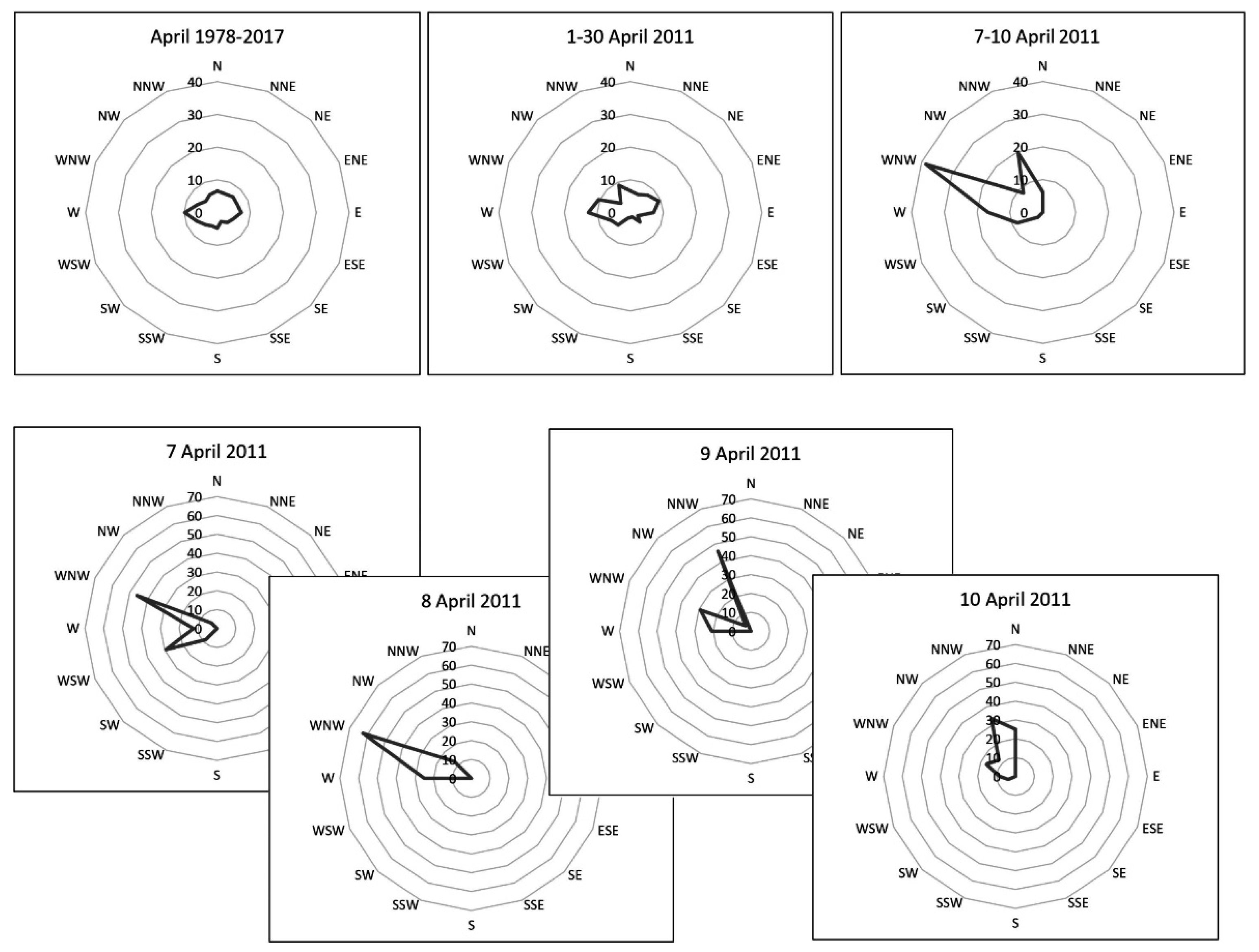


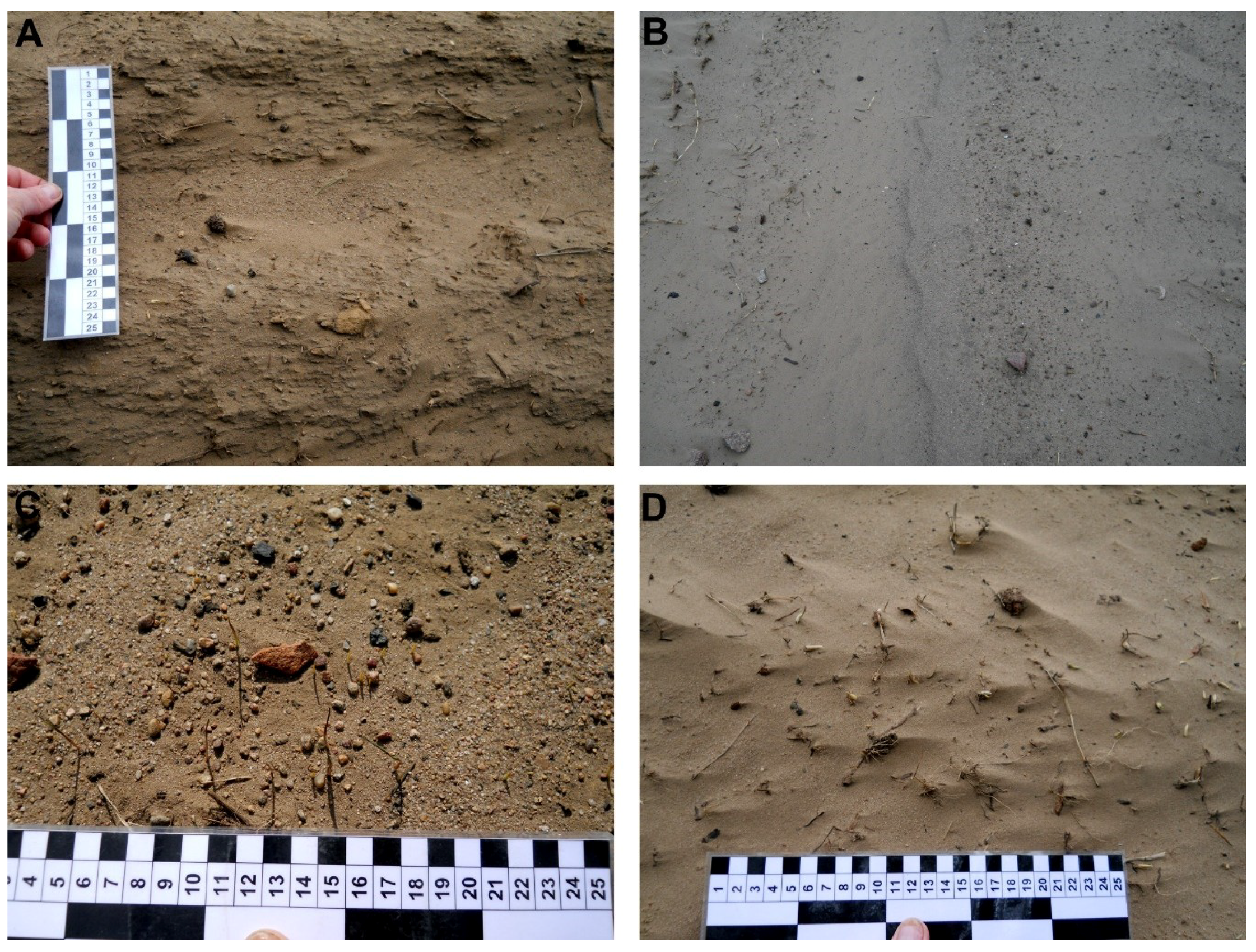
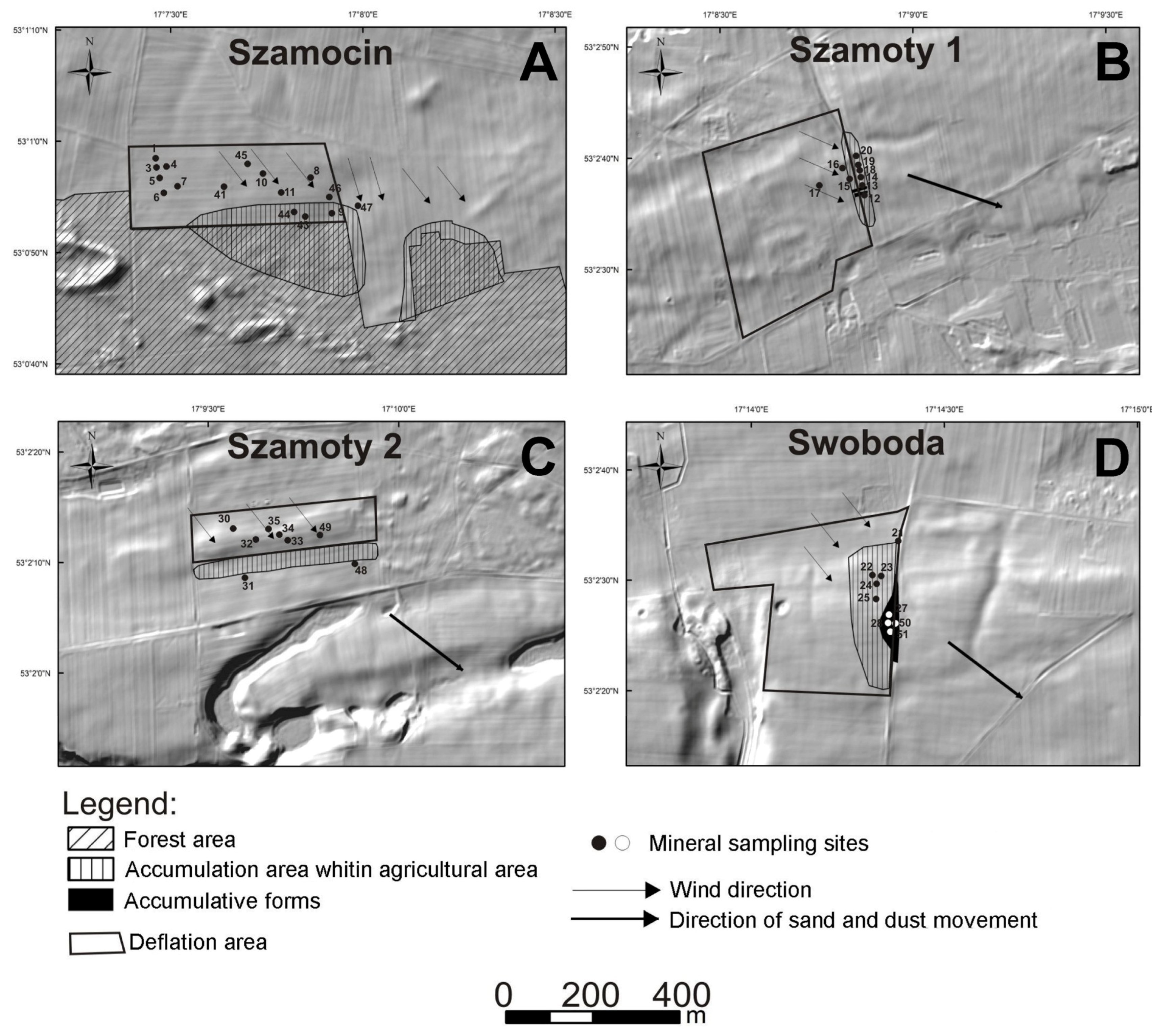
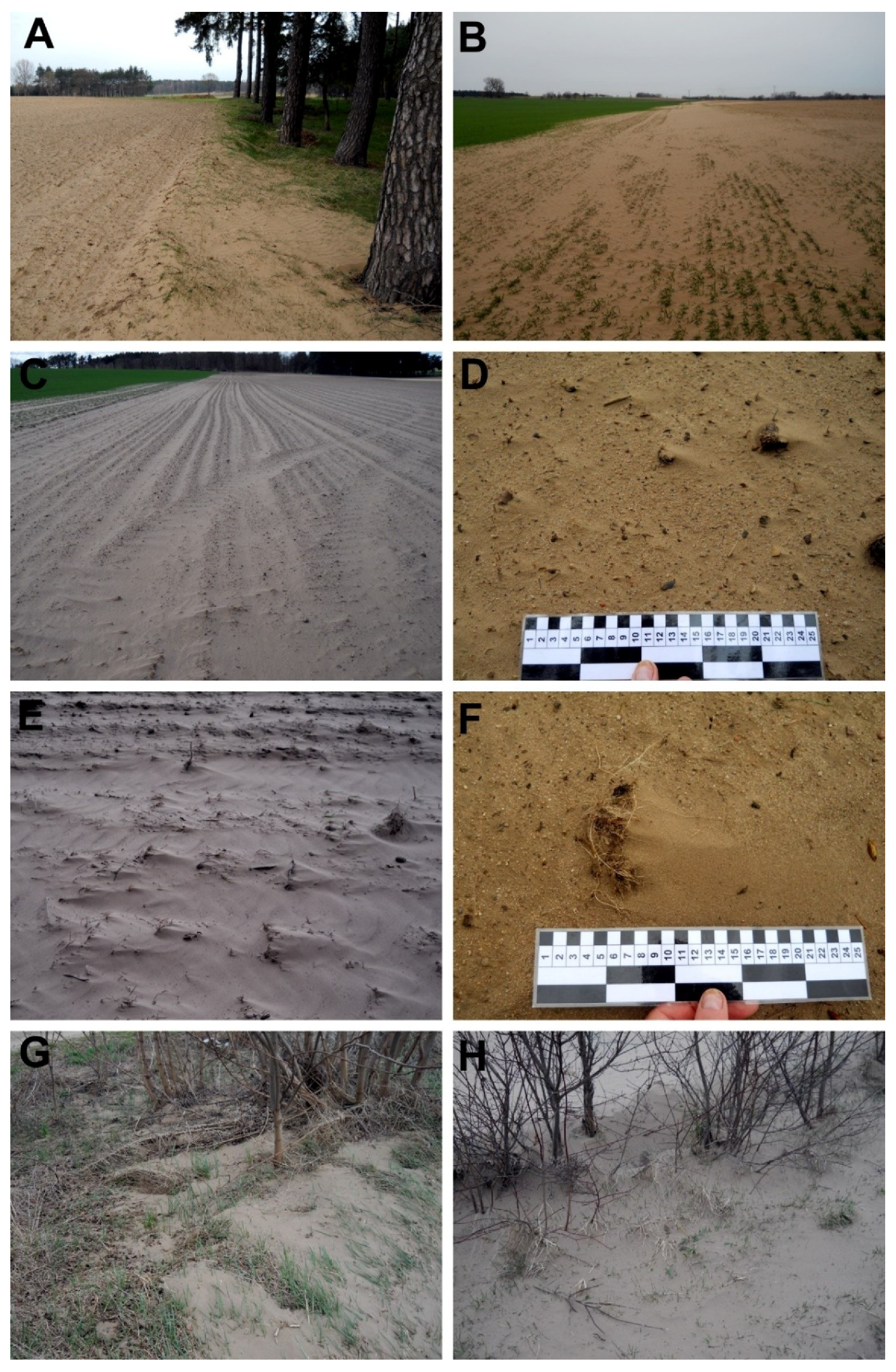
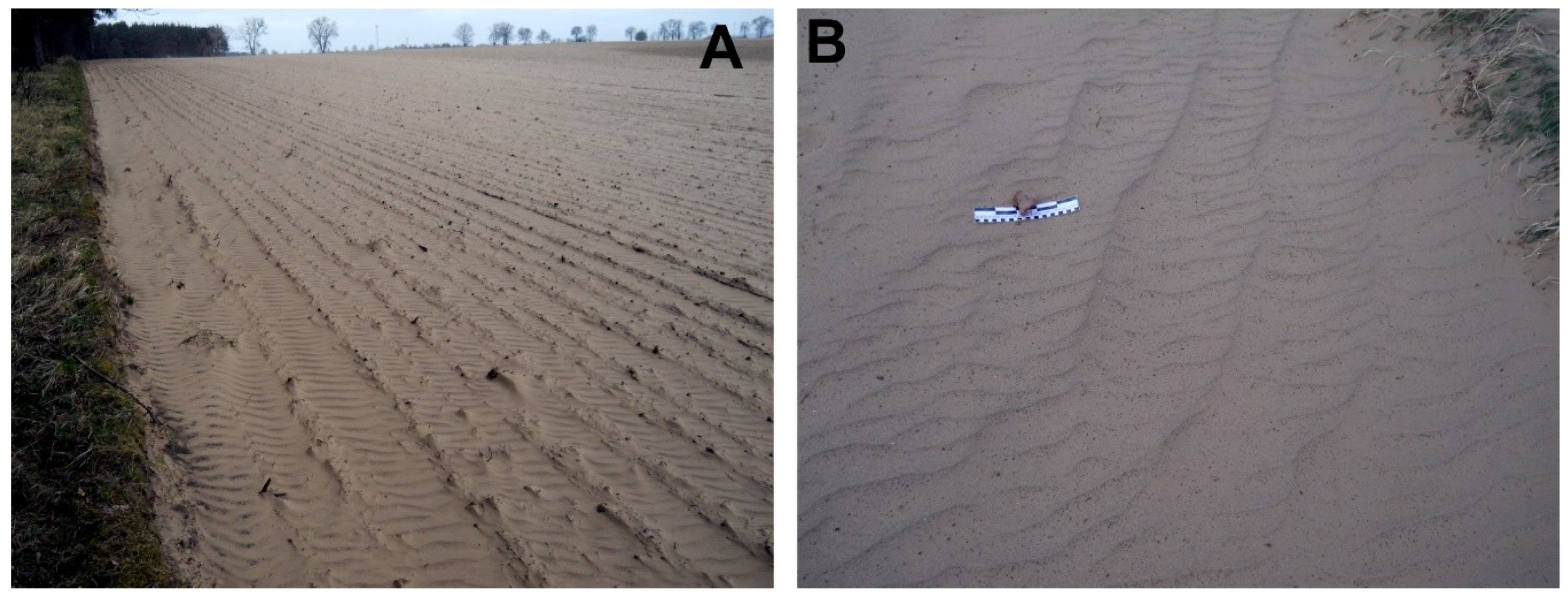
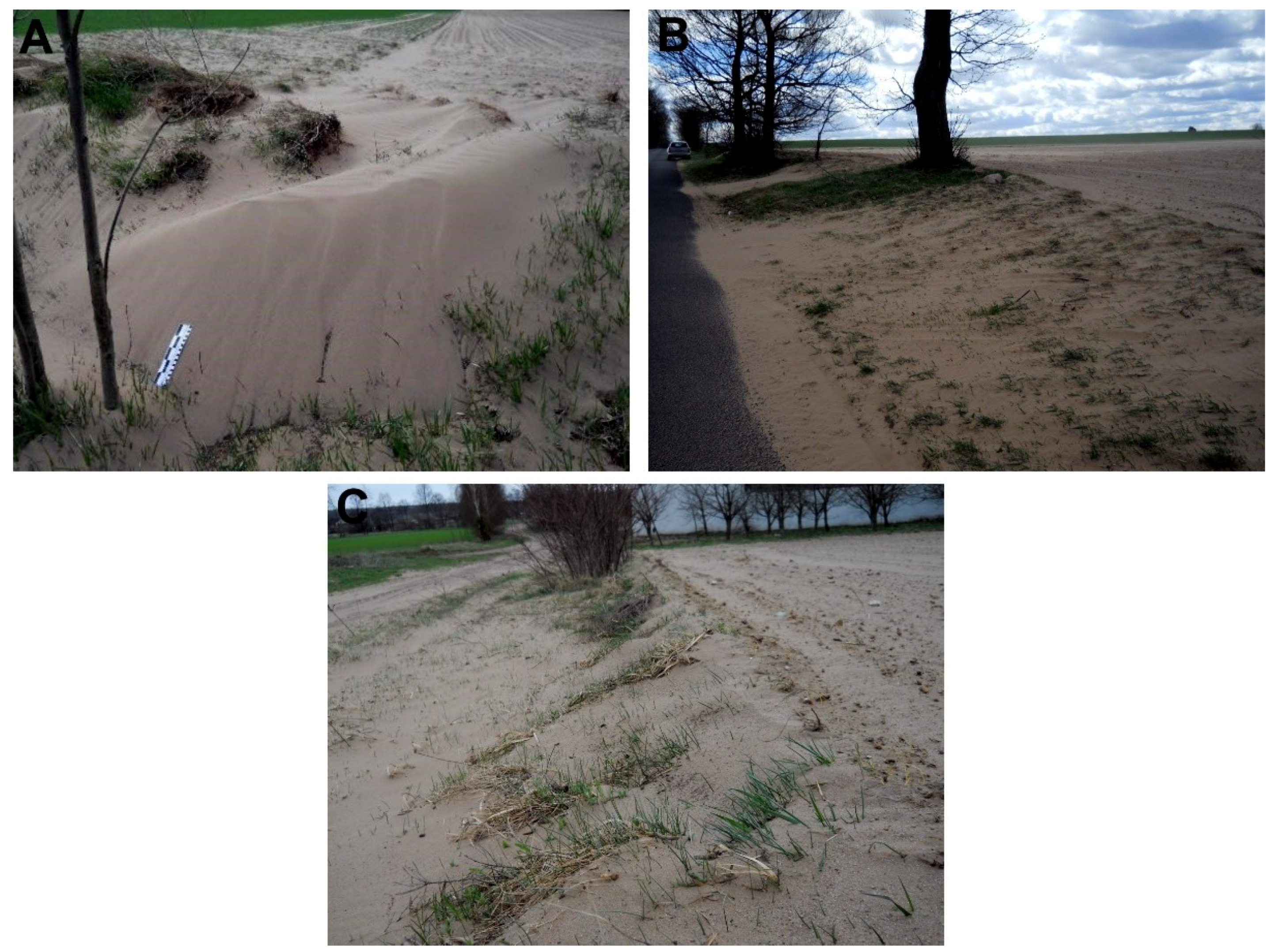

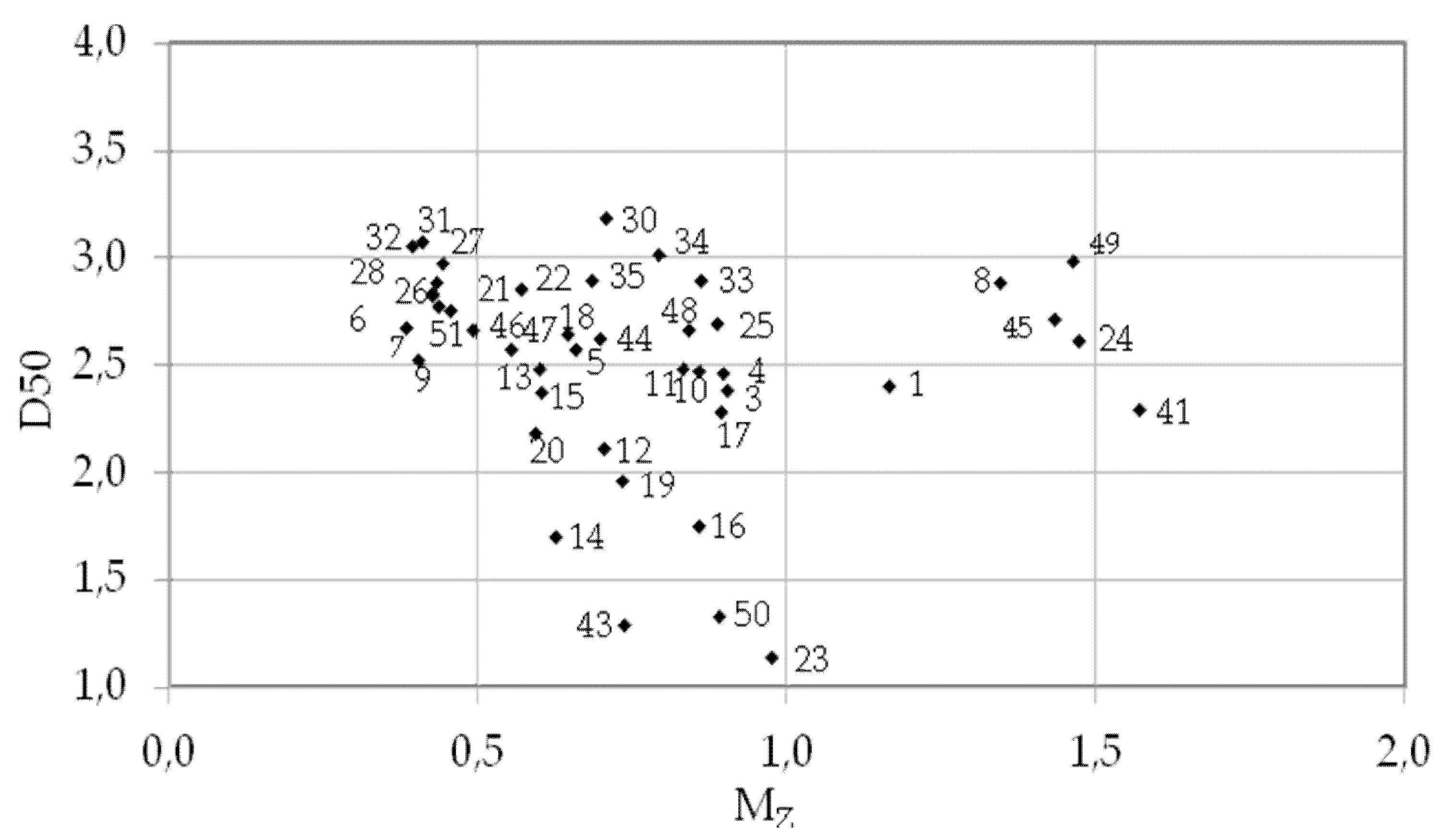
| Temperature [°C] | Humidity [%] | Wind Speed [m·s−1] | Wind Gust [m·s−1] | Wind Direction [°] | Precipitation [mm] | |||||||||||||||||||
|---|---|---|---|---|---|---|---|---|---|---|---|---|---|---|---|---|---|---|---|---|---|---|---|---|
| Days of April | ||||||||||||||||||||||||
| Hours | 7 | 8 | 9 | 10 | 7 | 8 | 9 | 10 | 7 | 8 | 9 | 10 | 7 | 8 | 9 | 10 | 7 | 8 | 9 | 10 | 7 | 8 | 9 | 10 |
| 0 | 12.2 | 7.6 | 7.5 | 3 | 96 | 67 | 71 | 72 | 3 | 6 | 6 | 1 | - | 12 | 11 | - | 249 | 294 | 292 | 280 | 0.1 | - | - | - |
| 1 | 12.7 | 7.3 | 7.2 | 2.7 | 95 | 70 | 70 | 75 | 4 | 6 | 5 | 2 | 9 | 12 | - | - | 258 | 293 | 299 | 280 | - | - | - | - |
| 2 | 13 | 7.1 | 6.9 | 2.3 | 94 | 72 | 69 | 77 | 3 | 6 | 5 | 2 | - | 11 | - | - | 257 | 305 | 299 | 290 | - | - | - | - |
| 3 | 13.2 | 7 | 6.2 | 1.4 | 93 | 72 | 71 | 84 | 3 | 7 | 5 | 2 | - | 14 | - | - | 255 | 306 | 293 | 300 | - | - | - | - |
| 4 | 13.2 | 6.9 | 5.6 | 0.9 | 93 | 74 | 74 | 86 | 3 | 5 | 4 | 2 | - | 0 | - | - | 241 | 302 | 293 | 290 | - | - | - | - |
| 5 | 13.4 | 6.9 | 5.7 | 2.6 | 92 | 75 | 73 | 78 | 4 | 5 | 5 | 2 | - | 12 | - | - | 246 | 299 | 289 | 290 | - | - | - | - |
| 6 | 12.9 | 6.9 | 6.7 | 5.1 | 94 | 74 | 69 | 68 | 4 | 6 | 5 | 3 | - | 12 | - | - | 226 | 300 | 311 | 325 | - | - | - | - |
| 7 | 13.9 | 6.9 | 7.7 | 6.6 | 91 | 75 | 61 | 62 | 4 | 5 | 6 | 5 | - | - | - | - | 235 | 290 | 328 | 336 | - | - | - | - |
| 8 | 15.6 | 7 | 9 | 8.5 | 82 | 76 | 52 | 56 | 5 | 5 | 5 | 5 | 10 | - | 10 | - | 255 | 290 | 341 | 328 | - | - | - | - |
| 9 | 17.6 | 7.4 | 9.6 | 10.3 | 74 | 79 | 45 | 49 | 6 | 5 | 5 | 6 | 11 | - | 10 | 12 | 260 | 280 | 344 | 333 | - | - | - | - |
| 10 | 19.8 | 7.3 | 10.5 | 12.1 | 51 | 85 | 41 | 46 | 6 | 5 | 7 | 6 | - | - | 13 | 11 | 277 | 270 | 336 | 329 | - | - | - | - |
| 11 | 19.2 | 8.1 | 10.8 | 13.5 | 45 | 78 | 38 | 44 | 9 | 5 | 7 | 6 | 15 | - | 12 | 11 | 280 | 270 | 330 | 332 | - | - | - | - |
| 12 | 14.6 | 9.1 | 10.8 | 13.5 | 73 | 69 | 39 | 43 | 7 | 6 | 6 | 8 | 12 | 12 | 11 | 13 | 288 | 260 | 343 | 328 | 0.3 | - | - | - |
| 13 | 13.3 | 11.4 | 10.6 | 13.4 | 77 | 63 | 38 | 40 | 8 | 8 | 7 | 6 | 15 | 16 | - | 12 | 288 | 273 | 338 | 327 | - | - | - | - |
| 14 | 12.2 | 12 | 11.5 | 12.9 | 83 | 64 | 36 | 33 | 7 | 6 | 4 | 5 | 12 | 13 | 9 | - | 289 | 270 | 342 | 360 | - | - | - | - |
| 15 | 11.4 | 12.7 | 10.9 | 11.8 | 70 | 63 | 36 | 35 | 5 | 7 | 6 | 5 | 11 | 14 | - | 10 | 304 | 290 | 332 | 353 | - | - | - | - |
| 16 | 11.1 | 11.9 | 9.8 | 11.4 | 60 | 64 | 39 | 43 | 5 | 9 | 6 | 4 | - | 18 | - | - | 301 | 290 | 330 | 8 | - | - | - | - |
| 17 | 10.5 | 10.6 | 9.6 | 10.8 | 60 | 60 | 41 | 51 | 6 | 9 | 5 | 3 | 13 | 15 | - | - | 297 | 300 | 333 | 349 | - | - | - | - |
| 18 | 9.8 | 10.2 | 7.4 | 9.6 | 53 | 65 | 50 | 56 | 7 | 8 | 2 | 2 | 13 | 16 | - | - | 298 | 299 | 290 | 10 | 0.2 | - | - | - |
| 19 | 9.4 | 10 | 5.2 | 8.1 | 57 | 66 | 61 | 60 | 7 | 8 | 2 | 1 | 14 | 16 | - | - | 296 | 295 | 270 | 10 | - | - | - | - |
| 20 | 9.1 | 9.3 | 4.8 | 6.1 | 59 | 69 | 63 | 68 | 7 | 6 | 2 | 2 | 12 | 13 | - | - | 294 | 296 | 270 | 329 | - | - | - | - |
| 21 | 8.7 | 8.7 | 3.9 | 5 | 60 | 70 | 67 | 73 | 7 | 7 | 2 | 1 | 12 | 12 | - | - | 296 | 306 | 270 | 306 | - | - | - | - |
| 22 | 8.3 | 8.5 | 3.7 | 4.8 | 63 | 68 | 66 | 76 | 7 | 7 | 2 | 1 | 12 | 15 | - | - | 294 | 299 | 270 | 306 | - | - | - | - |
| 23 | 7.9 | 8 | 3.7 | 5.1 | 65 | 70 | 67 | 74 | 7 | 5 | 2 | 1 | 13 | 10 | - | - | 292 | 300 | 280 | 246 | - | - | - | - |
| Place of Sampling | Length [m] | Width [m] | Surface [m2] | Average Thickness [m] | Min Thickness [m] | Max Thickness [m] | Amount of Material in Form [m3] | Total Amount of Material in Form [t] | Weight of Material in Form [t/km−2] |
|---|---|---|---|---|---|---|---|---|---|
| Szamocin Field (area 8.5 ha) | |||||||||
| tongue | 30 | 17 | 510 | 0.025 | 0.02 | 0.03 | 12.75 | 19.0 | 372.5 |
| rut | 50 | 1.2 | 60 | 0.085 | 0.07 | 0.1 | 5.1 | 7.60 | 1266.5 |
| hump between ruts | 50 | 0.6 | 30 | 0.04 | 0.02 | 0.06 | 1.2 | 1.8 | 596.0 |
| winter crop strip | 50 | 3 | 150 | 0.025 | 0.02 | 0.03 | 3.7 | 5.6 | 372.5 |
| Szamoty 1 Field (area 2.4 ha) | |||||||||
| aeolian cover | 100 | 2 | 200 | 0.04 | 0.02 | 0.06 | 8 | 11.9 | 596.0 |
| Szamoty 2 Field (area 3.6 ha) | |||||||||
| aeolian cover | 480 | 8 | 3840 | 0.06 | 0.04 | 0.08 | 230.4 | 343.3 | 894.0 |
| Swoboda Field (area 6.6 ha) | |||||||||
| drift 1 | 0.75 | 0.5 | 0.375 | 0.19 | 0.14 | 0.24 | 0.07 | 0.1 | 2831.0 |
| drift 2 | 62.5 | 5 | 312.5 | 0.05 | 0.04 | 0.06 | 15.6 | 23,9 | 745,0 |
| cover in ditch | 125 | 2 | 250 | 0.1 | 0.07 | 0.13 | 25.0 | 37,2 | 1490,0 |
| Average | 35.5 | 50.04 | 1018.0 | ||||||
| Actual accumulation (sum of sediments from all forms) | 336.12 | 450.4 | 9164.0 | ||||||
| Research Field | Sample Number | Mean Grain Diameter (phi) | Sorting (phi) | Sorting (phi) |
|---|---|---|---|---|
| Szamocin Field | 8 | 2.57 | 1.344 | poorly |
| 9 | 2.54 | 0.403 | well | |
| 10 | 2.48 | 0.858 | moderately | |
| 11 | 2.44 | 0.832 | moderately | |
| 24 | 0.92 | 1.366 | poorly | |
| 41 | 1.91 | 1.57 | poorly | |
| 43 | 0.95 | 1.35 | poorly | |
| 44 | 2.61 | 0.697 | moderately well | |
| 45 | 2.33 | 1.431 | poorly | |
| 46 | 2.66 | 0.492 | well | |
| 47 | 2.59 | 0.554 | moderately well | |
| 1 | 2.24 | 1.165 | poorly | |
| 2 | 1.85 | 0.998 | moderately | |
| 3 | 2.32 | 0.903 | moderately | |
| 4 | 2.40 | 0.896 | moderately | |
| 5 | 2.57 | 0.658 | moderately well | |
| 6 | 2.80 | 0.435 | well | |
| 7 | 2.64 | 0.384 | well | |
| 30 | 3.17 | 0.708 | moderately | |
| 31 | 3.06 | 0.409 | well | |
| 32 | 3.04 | 0.394 | well | |
| 33 | 2.74 | 0.861 | moderately | |
| 34 | 2.91 | 0.793 | moderately | |
| 35 | 2.85 | 0.685 | moderately well | |
| Szamoty Field 1 | 12 | 2.17 | 0.704 | moderately |
| 13 | 2.51 | 0.599 | moderately well | |
| 14 | 1.75 | 0.625 | moderately well | |
| 15 | 2.39 | 0.602 | moderately well | |
| 16 | 1.84 | 0.858 | moderately | |
| 17 | 2.30 | 0.892 | moderately | |
| 18 | 2.67 | 0.644 | moderately well | |
| 19 | 2.09 | 0.734 | moderately | |
| 20 | 2.24 | 0.594 | moderately well | |
| Szamoty Field 2 | 48 | 2.57 | 0.84 | moderately |
| 49 | 2.52 | 1.463 | poorly | |
| Swoboda Field | 21 | 2.88 | 0.427 | well |
| 22 | 2.86 | 0.569 | moderately well | |
| 23 | 1.38 | 0.976 | moderately | |
| 24 | 2.25 | 1.471 | poorly | |
| 25 | 2.61 | 0.887 | moderately | |
| 26 | 2.87 | 0.427 | well | |
| 27 | 2.99 | 0.441 | well | |
| 28 | 2.93 | 0.434 | well | |
| 50 | 1.52 | 0.889 | moderately | |
| 51 | 2.77 | 0.456 | well |
© 2019 by the authors. Licensee MDPI, Basel, Switzerland. This article is an open access article distributed under the terms and conditions of the Creative Commons Attribution (CC BY) license (http://creativecommons.org/licenses/by/4.0/).
Share and Cite
Hojan, M.; Rurek, M.; Więcław, M.; Krupa, A. Effects of Extreme Dust Storm in Agricultural Areas (Poland, the Greater Lowland). Geosciences 2019, 9, 106. https://doi.org/10.3390/geosciences9030106
Hojan M, Rurek M, Więcław M, Krupa A. Effects of Extreme Dust Storm in Agricultural Areas (Poland, the Greater Lowland). Geosciences. 2019; 9(3):106. https://doi.org/10.3390/geosciences9030106
Chicago/Turabian StyleHojan, Marcin, Mirosław Rurek, Mirosław Więcław, and Adam Krupa. 2019. "Effects of Extreme Dust Storm in Agricultural Areas (Poland, the Greater Lowland)" Geosciences 9, no. 3: 106. https://doi.org/10.3390/geosciences9030106
APA StyleHojan, M., Rurek, M., Więcław, M., & Krupa, A. (2019). Effects of Extreme Dust Storm in Agricultural Areas (Poland, the Greater Lowland). Geosciences, 9(3), 106. https://doi.org/10.3390/geosciences9030106





